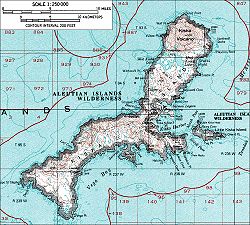Kiska Island
| Native name: Qisxa | |
|---|---|

A topographical map of Kiska
|
|
| Geography | |
| Coordinates | 51°57′51″N 177°27′36″E / 51.96417°N 177.46000°ECoordinates: 51°57′51″N 177°27′36″E / 51.96417°N 177.46000°E |
| Archipelago | Rat Islands group of the Aleutian Islands |
| Area | 107.22 sq mi (277.7 km2) |
| Length | 22 mi (35 km) |
| Width | 1.5 mi (2.4 km) - 6 mi (10 km) |
| Highest elevation | 4,004 ft (1,220.4 m) |
| Highest point | Kiska Volcano |
| Administration | |
|
United States
|
|
| State | Alaska |
| Census Area | Aleutians West Census Area |
| Demographics | |
| Population | 0 (2010) |
Kiska (Aleut: Qisxa) is an island in the Rat Islands group of the Aleutian Islands of Alaska. It is about 22 miles (35 km) long and varies in width from 1.5 to 6 miles (2.4 to 9.7 km). It is part of Aleutian Islands Wilderness and as such, special permissions are required to visit it.
In 1741 while returning from his second voyage at sea during the Great Northern Expedition, Danish-born Russian explorer Vitus Bering made the first European discovery of most of the Aleutian Islands, including Kiska. Georg Wilhelm Steller, a naturalist-physician aboard Bering's ship, wrote:
On 25 October 1741 we had very clear weather and sunshine, but even so it hailed at various times in the afternoon. We were surprised in the morning to discover a large tall island at 51° to the north of us.
Prior to European contact, Kiska Island had been densely populated by native peoples for thousands of years.
Kiska, and the other Rat Islands, were reached by independent Russian traders in the 1750s. After the initial exploitation of the sea otter population, Russians rarely visited the island as interest shifted further east. Years would frequently pass without a single ship landing.
Starting in 1775, Kiska, the Aleutian Islands, and mainland Alaska became fur trading outposts for the Russian-American Company managed by Grigory Shelekhov.
In 1867, U.S. Secretary of State William H. Seward negotiated the purchase of Alaska with the Russian Empire. Kiska was included in the purchase.
...
Wikipedia
